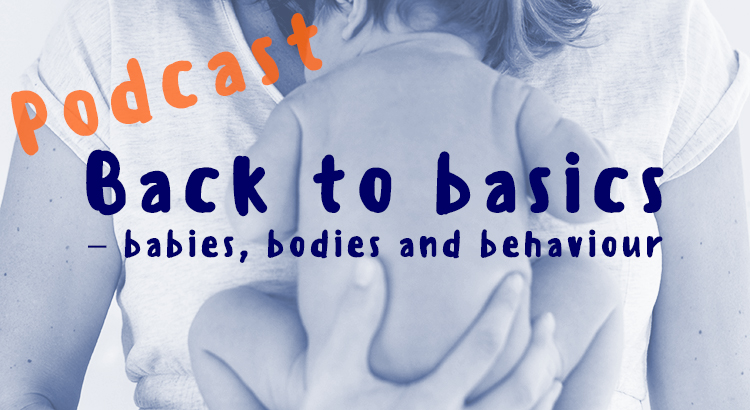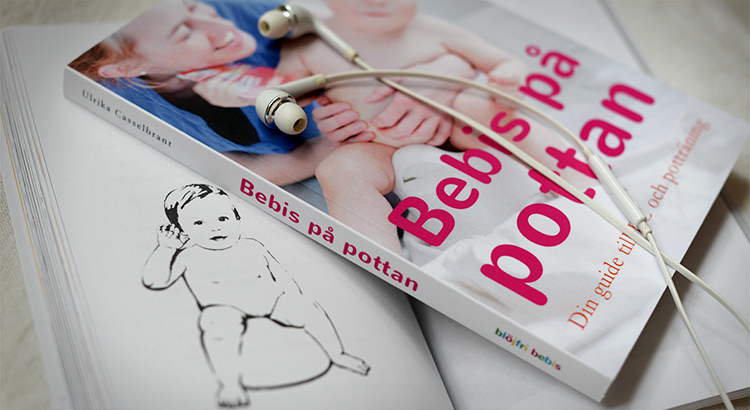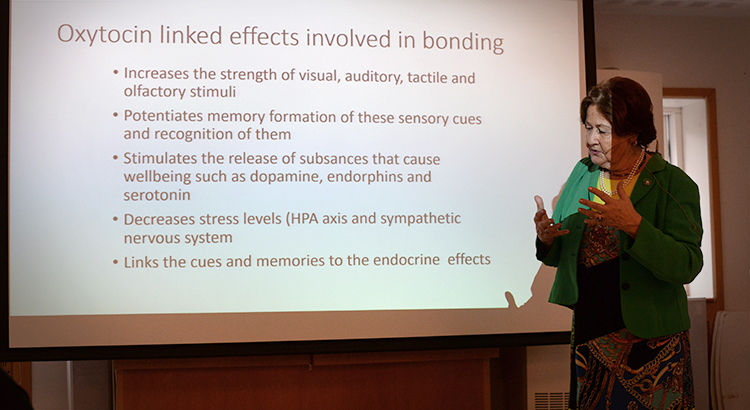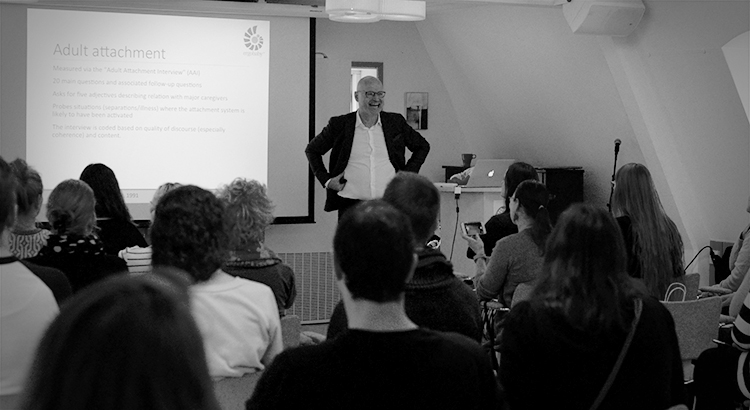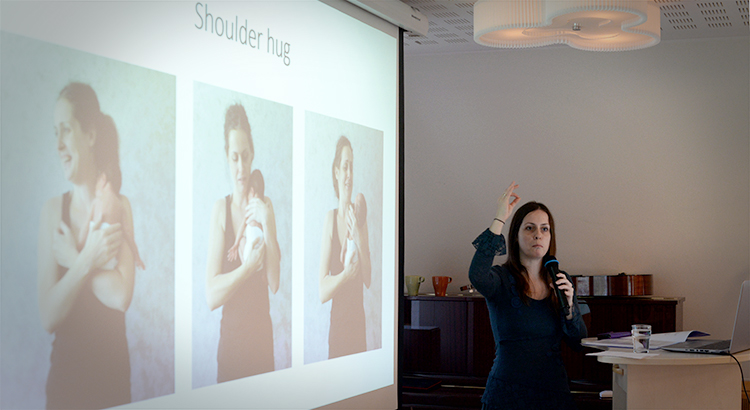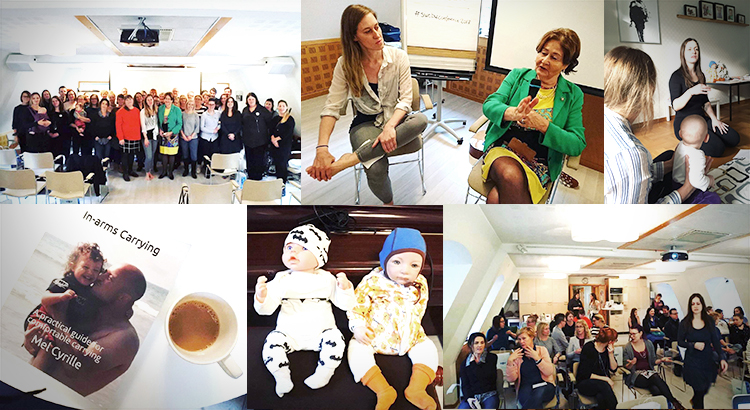Tillsammans med Mel Cyrille, som är bärandekonsult och författare till boken In arms carrying har jag dragit igång en pod, Back to basics – babies, bodies and behaviour. Podden är tänkt att beröra allt från bärande, babypottning, barfota, föräldraskap och mer!
Här kommer vårt pilotavsnitt. I avsnittet har vi fokus på bärande av barn i armarna/famnen och de primitiva reflexer som barnet använder för att hjälpa till vid bärandet. Vi kommer även in på en del annat! Lyssna till eller ladda ner avsnittet här. Du hittar det även där poddar finns, hos tex Acast och Podcaster. Se transkription av avsnittet nedan.
Transkription Back to basics – babies, bodies and behavior
Avsnitt 1 In-arms carrying – reflexes
Ulrika: “Welcome to this pod with Mel Cyrille and Ulrika Casselbrant and I guess we should start with introducing ourselves. My name is Ulrika and I live in Stockholm Sweden, and I’m a babywearing consultant and also elimination communication consultant. I wrote a book about Elimination Communication and I’m very much into babywearing and in-arms carrying as well.”
Mel: “I’m Mel, l’m from Carried, and I’m a babywearing and in-arms trainer and the author of in-arms carrying. My work has a very strong in-arms focus which I incorporate into my babywearing trainings too.”
Ulrika: “Yes, and we decided on that a pod may be good to be able to discuss some of the subjects and I guess we are probably going to start out with in-arms carrying today….”
Mel: “Yep” *laughs*
Ulrika: “….and maybe start out with like, a definition….
Mel: “Yes”
Ulrika: “….like, what is in-arms carrying?”
Mel: “Yeah”
Ulrika: “….if you want to take that one….how do you see in-arms carrying?”
Mel: “So…in-arms carrying is basically an umbrella term for anything from holding through to independent clinging, basically. It’s sort of, on body behaviours, basically, so we’re talking about a spectrum of how we support babies on our bodies.”
Ulrika: “Yes. And what about reflexes has to do with this?”
Mel: “OK, so, in the beginning, when babies are born they’re born with a whole host of primitive reflexes and these reflexes are for things like
feeding so they, they, they help babies to survive basically. So feeding reflexes and, like, the rooting and sucking reflex as it enables them to To ingest milk without being aware of how to do it….
Ulrika: “Mmm hmm”
Mel “….so with the carrying reflexes they enable the baby to sort of fit to our body and help with the carrying process before they are aware of how to do it voluntarily….”
Ulrika: “Mmm hmm”
Mel “….yes.”
Ulrika: “And there are a bunch of reflexes helping this and one of the most people notice without thinking about carrying or not, is like when you pick up a newborn baby, they pull up their knees….”
Mel: “Yep that’s right, yep.”
Ulrika: “….so that’s one of them.”
Mel: “Yeah.”
Ulrika: “And it’s very different to carry the baby if it has the knees up or dangling down….”
Mel: “Absolutely, yes.”
Ulrika: “….such a big difference, so they’re really really helping out with this reflex
Mel: “Yup that’s right.”
Ulrika: “But then, on the body something interesting is happening as well – like if the feet are pulled down or their they’re losing the foot down…. I’m sorry for my English, it’s going to be a bit rocky….I know!” *laughs*
Mel: *laughs* “It’s absolutely fine, we know what you’re talking about!”
Ulrika: “But, uh, Yes I think we’ll be able to manage if I don’t have to spell….”
Mel: *laughs*
Ulrika: “Yes, yes….But, yeah, when the foot slips down there is also a reflex or two and it do you want to talk some about that?”
Mel: “Yeah, so, basically, the different reflexes tend to be talked about as separate things and, sort of the reaction elicited by it and salt together but when we look at the reflexes in action, they they work together harmoniously, and they can sort of trigger a chain reaction sort of thing so the foot reflexes, the grasping and fanning actions of the feet, so we’ve got the plantar grasp reflex and Babinski’s sign in babies – these, these are normal reflexes to have and the grasping reflex helps with clinging onto the body and is one thought to be thought to be a leftover reflex from when humans had lots of body hair…. but we see it in action all the time on the body anyway, and it helps a clinging onto clothing and onto skin as well. It still is used in carrying and the Babinski sign is the sort of stabilising action so the toes fan out and it creates a wider surface to stabilize on the body with but also while, while these reflexes are happening if if the foot and leg slip down the body and these reflexes are happening at the same time you get this this reaction of the leg being brought up. So it’s, it’s a sort of a correctional sort of reflex this but it’s umm….but of course it is triggered by the foot, the, the….*sighs* *laughs* can’t think of the word now!”
Ulrika: *laughs*
Mel: “….but, yeah, it’s, it’s coming through from sensations from the foot. So it’s, its most commonly known as the Stepping reflex but when we look at it on the body, it’s what I like to call a clinging adjustment reflex, because that action of the sudden trigger of the leg and knee coming up and sort of forwards as well on the body is enabling them to cling onto the body and correcting their position from having slipped down, so coming back up….. I don’t know if if that explains it well enough I’m not really good with describing in words!” *laughs*
Ulrika: “Mmm….I can see them making this, like, really high…knees, and it doesn’t look like walking actually.”
Mel: “No!”
Ulrika: “It looks more like this military exercise….for I don’t know, some kind of, show or parade or something!”
Mel: “Yes, exactly! And it’s like, it’s been given this name, oh, well, it looks like a weird form of walking so we’re going to call it the “stepping reflex” but….when, when, for SO many reflexes, when you look at them in action on the body, it’s, it’s like, you know, you’re putting…. you just see, you see it from from a completely different perspective and so, so, so many of the reflexes primitive and postural reflexes are used in carrying. So, so many are linked to carrying, and it feels like I keep discovering more and more related to carrying and it’s so exciting!” *laughs*
Ulrika: “But why is this something that we’re discovering now? Why is this not something that the doctor is telling you when you go with your first appointment with your baby?
Mel: “Because….*laughs* it’s a couple of things….well probably more than a couple of things, but two big things that stand out for me are…. Patriarchy – so science and what have you, well, the recorded science that we have comes from a male perspective. You know, when these reflexes were being found and everything….
Ulrika: “It was men, you know, not taking care of babies and making the definitions.”
Mel: “….yeah, exactly. So it’s, coming from, from a different perspective again but also we, we haven’t been carrying our babies normally for a very, very, very long time. I mean, you know, you know how, how little there is, recorded history of carrying our babies and the, the little history that we have found, it is not to do with carrying as you and I have come to know it!”
Ulrika: “Yeah, yeah….”
Mel: “So we haven’t had any sort of, point of reference before, so that’s why, that’s why it’s so important for us to be getting this message out there and alerting the people who, who will then be able to take this further and, you know, talk to parents about this you know?”
Ulrika: “Yes and I’m thinking that this with carrying both babywearing and in-arms is….should be an interesting field to dig into for research. It’s like, it’s the biomechanics of two bodies, a lot of tissue, a lot of nerves, a lot of like, muscles going on. The needs of the one carrying, the needs of the one being carried, and communication, like cultural aspects and like how
cultural influences how we carry and what decisions we are making and what needs we have in the culture we live in and….such an interesting field to do research on. And how it affects our lives as well. Every day lives of mothers and fathers because everyone is carrying….” *laughs*
Mel: “Yeah, pretty much everyone does it every single day!”
Ulrika: “‘Cause it’s like, included in taking care of children and I guess it’s like, because it’s such an everyday thing people do that’s also a part of life. I have been recording and documenting some of, I’m going through this archive with a lot of like, old Swedish pictures of people, people have sent in, recording history, that’s like, thirty, thirty thousand, and in Swedish it’s called …….. I think, and I found a couple of carrying, but it’s not a lot like, it’s on Christmas trees and picturing people doing like, their everyday chores with their, with their babies.”
Mel: “Yes. And I think, as well, the lack of information and history, again it’s coming back to who was recording history, you know, so….it’s, it’s, it really wasn’t seen as something important, you know, the mother’s work and stuff and….. I have a book, I’m just going to check to see when it was written but I found this awesome book a while back when I was doing some research into elimination communication to, to try and find out a bit more about how we used to practice EC to a certain extent you know, over the ages, you know. It was common for babies to be potty trained by 1 so…. it was from 1964 but it’s, it’s going back in time as well, but, um, yeah! Nothing about holding or carrying your baby. Lots of interesting stuff about feeding and nappying and all that sort of thing, but nothing nothing about holding and carrying, and it’s just, it’s just not been thought of as a THING, basically, ‘cause it’s just seen as something we do to or for the baby. It’s not seen as a reciprocal thing is it?”
Ulrika: “Mmmm….so I guess back to the reflexes then as that’s been discussed about why we don’t know more about this, but looking into it, it gets more and more clear when you see it actually. But there’s also with the body alignment of the child with, it’s very different to carry a small baby that is leaning into you or if it’s leaning back, or, or, if it’s wobbly, it really affects how heavy it feels when you carry the baby. So even when it’s sleeping, and not really active, it’s still active with its body I would say with its posture.”
Mel: “Yeah absolutely. Yeah so you see it, so some, some reflexes are won’t be elicited in deep sleep but we see the….what do we call it? The squat reflex? I don’t know, but the, the knees up…..
Ulrika: “Yeah, the squat reflex could be a good name.”
Mel: “So, we, we see that reflect in Action even when they’re in deep sleep on the body don’t we, so it’s like it’s designed to help, help them bear some of their weight. I mean we, we played around with, with the demo dolls in Sweden didn’t we – feeling the difference between a demo doll which has been wired so that the knees are up and this has adopted that posture and the demo doll with legs down it affects both how it fits to the body obviously but also how heavy it feels, it’s all part…..
Ulrika: “Yes, I couldn’t imagine, I couldn’t imagine before trying that it will be such a difference but it really really is, definitely. So what do we have more when it comes to the reflexes? Because the one the doctors say is one of the strongest ones left over from history, from prehistoric time, the ones clinging to the hair, the reflex of the gripping of the, the fingers and the hands.
Mel: “Oooo, yeah, so that’s still seen in action in carrying, it’s still used, I mean you just all you have to do is just watch somebody hold their baby and you see, you see it in action – it’s not just about body hair at all, so yeah, it’s really interesting on the body – so many and one that I’ve been looking into recently actually, which isn’t a primitive reflex, it stays for life. It’s to do with boys and I’m not sure if I’m going to pronounce it correctly but…. I’m just going to look at the word to try and pronounce it * laughs* cremasteric [cree-masteric] reflex or cremasteric [crem-asteric], something like that but it’s, it’s to do with when, when either one or both testicles draws up into the body….”
Ulrika: “Ohhh yes! Ok then, yes, Katy Bowman speaks about that one….”
Mel: “Oh does she! Ah, awesome.”
Ulrika: “Yes. You shouldn’t wear underwear – men shouldn’t wear underwear because it can’t work properly….yeah.”
Mel: “OK, interesting, I’ll have to look that up.”
Ulrika: “And maybe there could be links to like, prostate cancer…..she’s just speculating, yeah, but yeah.”
Mel: “OK, so with carrying…. So I have this massive, massive thing about knots being tied under bums in babywearing, you know, just, just, just keep everything away from the bum, kind of thing because of the pressure created over time. So I got to thinking about carrying, you know, as I have boys, and I got to thinking about how, you know, what what happens with the testicles kind of thing and got to thinking about, you know, this reflex and stuff, and sort of kind of observed it in action with Isaac as well. It’s, and it’s elicited by stroking or pressure to, to the inner thigh and it’s like…. “oh my God we have another one!” ‘Cause I’d been thinking about um….’cause obviously I don’t FEEL his testicles when I’m carrying him, and you know, you’re thinking about where, where you’re carrying them and you know get to the bony part of the hip as well obviously, when, when they’re actively clinging it’s less of an issue about where they’re positioned on your body because they’re gripping as opposed to bearing all of their weight on to certain part of the body, but, but yeah this reflex is in action in carrying as well and I find it amazing….”
Ulrika: “What happens when it’s triggered?”
Mel: “The testicles are drawn up into the body.”
Ulrika: “….they are drawn up? And then they are heated up against….coz that’s like part of the muscle….”
Mel: “Sorry?”
Ulrika: “They lose…. part of their muscle use…reflex, they should be loosened when they are too hot so they can cool down, why they can move up and down.”
Mel: “So yeah, it’s just, yeah another, I mean like I always say we’ve only scratched the surface with carrying and just it’s amazing how, how many things that you wouldn’t think are linked to carrying actually are linked to carrying and, just yeah, how amazing….”
Ulrika: “But what happen if you carry the small baby on your hip, I can’t really, not having a baby here, I can’t really see where, like, the, the….the boy’s “package”, I don’t know what you would call it in English, but where is it, where does it, does it come towards like, your belly or….depending
on how they sit I guess? So if they cling actively, there is not the pressure on it, but they would still be pushed up by this?”
Mel: “So, um, when they’re sitting in a legs up kind of position then it kind of all comes up and onto your body if that makes sense, it just….squishes, basically! *laughs* So yeah, yet another very useful side effect of skin to skin carrying – you get to see what is actually happening, so yeah, and this is kind of where thoughts about what is happening with the testicles and stuff came from, when I had had a shower with him and observing where everything was. But yeah….”
Ulrika: “ Hmmm…Hello!!! We want some researcher to look into this please!”
Mel: “Yes! Please! Please!!!” *laughing* “But I guess also, we should mention what happens after the reflexes integrate – it’s not all about the reflexes is it? It all BEGINS with the reflexes….so maybe you want to take that one?”
Ulrika: “But you are the expert here on the subject! *laughing* I’m just coming with all these thoughts, um, you mean the reflexes are integrated? Yeah…umm and all reflexes are not integrated at the same time and some are not even integrated, they stay as reflexes, like sneezing or coughing if you get something in your throat it hurts like that, but sneezing and coughing it’s not that much connected to carrying, but who knows!”
Mel: “Oh don’t, you just put thoughts in my head about sneezing! What the body does when it sneezes….can you visualise that on-body, baby sneezing? And what the baby does? It’s linked to carrying – oh my God!” *laughs*
Ulrika: “Yes, it pulls itself forward! It does! So it makes a secure position being able to do that….”
Mel: “I LOVE Chatting with you – we have the best conversations!” *laughs*
Ulrika: “Yes that’s true, that’s….’cause it would be really bad for them if they did the opposite, you know? Throwing themselves back would be dangerous so it really is also an argument for, yeah, babies are used to be carried because in that position they would make themselves
safe….yeah…. But yeah, after a while these reflexes are integrated, like, the reflex. I don’t know what you call, I guess it’s like a combination of reflexes, like that they start to cling on your body with their, pressing their knees together, what reflex would that actually be connected to? Or is it like, several? Is it two, or several”
Mel: “Yeh it begins with that, yeah….”
Ulrika: “But is not just the squatting, it’s also they clinging of the knees together….”
Mel: “It’s umm…. I mean you can cling just down to the knees but depending on how they’re being carried, down the calf as well and all the way down to the foot, and it also depends on what they’re wearing as well doesn’t it, but like you say what what is the actual reflex? And the thing is I believe there’s a lot of undiscovered stuff out there. We’re trying to, sort of, work out what of the reflexes that have been discovered or whatever, what are related to carrying? But carrying is a completely different thing in and of itself isn’t it, and some of those reflexes are probably ones that we don’t know about, are probably ones which may, may not be seen elsewhere. Does that make sense?
Ulrika : “Mmm, yeah.”
Mel: “Yeah, so, yeah I’ve seen it as a combination of different reflexes. As as I said in the beginning, they they don’t tend to just work by themselves exclusively, only if we test them, they tend to work in sort of groups or pairs or you know, depending on what what’s happening so yeah I think we’re talking about uncharted territory here, basically. Because some of the reflexes ARE linked to it. Sorry….”
Ulrika: “No and maybe if a small baby also sneezes then it probably would press also the knees together so….I probably would imagine that would happen so….”
Mel: “They do! But yeah, so, this is why it’s so important to encourage the clinging behaviours, because a clinging baby feels LIGHTER than a non-clinging baby! You know, it’s like, I mean, I, I use a, my….”
Ulrika: “And the clinging, no sorry….”
Mel: “Sorry, no you….”
Ulrika: “So also, the clinging baby will also, it will benefit the building of muscles for the baby so the baby gets stronger earlier and can do….”
Mel: “But yeah….*sigh* it does, but at the same time, it gets stronger as it SHOULD.”
Ulrika: “Mmmm.”
Mel: “And that’s the thing, we’re, we’re not talking about, umm…”oooo let’s create some super babies, it’s literally just a normal part of their development, isn’t it, that a lot of babies are missing out on.”
Ulrika: “Yeah, we’ve lowered our minimum.”
Mel: “Mmmmm.”
Ulrika: “And that’s also like, expectations in different cultures, I’ve come across in reading as well, and some countries you expect a baby to be a much earlier crawler or a much earlier walker or steady, steady head and…these cultures they do a lot more carrying also more of baby massage and handling the babies in other ways. Not being really super careful….giving them more…..I can’t find the right…”
Mel: “Freedom of movement?”
Ulrika: “Yeah, yeah maybe and more like, challenges, more physical challenges.”
Mel: “Yeah, so like not treating them as….”delicate”, basically?”
Ulrika: “Yes. And of course then depending on like how strong they are and so on but not not expecting them to be really really super delicate.”
Mel: “Mmmm. So what I was saying about the thing with with slings…. so you know they, they feel lighter when they’re clinging that, that kind of leads on to the fact that what I call “active carrying” is where the baby is actively clinging but that’s also tied into their state of alertness as well isn’t it, it’s, active carrying is when is for when they are active and alert and in, in that kind of stage where they are wanting to move and interact with the environment and everything whereas babywearing is more of….can’t think of the word now….*laughing* Erm babywearing is more
passive, isn’t it, and erm, it inherently encourages sort of, stillness and calmness, doesn’t it?”
Ulrika: “Yeah and those times when the baby needs to be calmed or needs to sleep.”
Mel: “Yeah, so it’s obviously….you know, we can use carrying or babywearing for whatever we like, it’s just like, pointing out the biological baseline for it, isn’t it. It seems like this active carrying is intended for when they are at this sort of state of alertness, whatever point in time that may be, and that babywearing um, well if we look at cultures around the world where it hasn’t been um, where it hasn’t been lost in the culture, it tends to be very much “out of sight”, doesn’t it? Very very strongly linked to back carrying around the world and even in English history as well, back carrying is the type of carrying, babywearing we’ve seen in history as well. Um so it seems like babywearing has been used for freeing up the front of the body and we’re a bit strange in the fact we wear babies on the front, but we’re coming from a place of privilege where we can use babywearing as a bonding tool as well, you know, and, but it seems like, like babywearing was invented so, so that we can get on and do things without having to leave, leave a sleeping baby laying on the ground somewhere….so they’re still connected to us. So, but, like I say we can use either however we like. I mean I will sometimes carry my sleeping 2 year old, but, um, you know, in-arms, but I much prefer to put him in a sling, you know, because it frees up the front of my body and everything, but um, no we can use carrying when they’re tired and sleeping anyway, and we can use babywearing when they are awake and active as well, it’s just literally trying to work out this biological baseline as to what each, what each might have an intended purpose for. Does that make sense?”
Ulrika: “Yeah yeah definitely and something which really got my interest the other day connected to this was erm, it’s like ok, the mother or father carrying or someone else carrying, they have their needs, I need to do this and that and it would be convenient for me to do this, that’s one aspect yes. But then the baby has its needs as well, and a small baby has very few minutes of the day where it’s active and then those other minutes when it’s quite sleepy and it’s with a 4 month old much more nosy and have much more active time where it’s alert and can take in the world. And one one of the mothers the other day that I met and she said when I carry the baby and it is active in my arms it is never bored. And this is of course I think here is doing active stages also. It can be a bit
tricky though to have an awake baby at 4 months old in the sling. It wants to move its body and be out there and maybe it’s these 15 minutes – I have no idea of time here, I’m just picking a time – to let the baby be active then, and maybe it will go back to being more OK I’m at the stage where I need to cuddle and I need to recharge myself and then I’ll be OK with sitting in the sling.”
Mel: “Yeah and this is the thing, this whole “nosy baby” stage and forward facing out and everything, and erm, sort of in the sling world, the idea is kind of to fix this problem, in a sense. Not that the baby is a problem, but you’re having this problem that your baby wants to look around, so, so we’re looking at how we can adapt this to slings. Which obviously we still need to do because people will still want to use slings at certain times when their baby is doing these things, BUT….if we take a step back and look at the behaviours that are going on, if we can carry them, like you said, if you’ve got these 15 minutes or whatever where you CAN meet the need that they are signalling, then why not carry them in arms for a bit? Because active carrying is, OH! It’s interacting with the world and it’s movement, and they’re wanting to engage with you and the world as well aren’t they? So, yeah.”
Ulrika: “Yeh and move their body as well, so….”
Mel: “I fully agree with you that umm, if we do have time to meet that need, then just meet it, because as you say, they’re probably going to be more settled after that period of activeness, aren’t they? And um, and be more likely to settle in the sling or carrier after.”
Ulrika: “Mmmm. Maybe this is a good timeframe for, for an episode, I imagine, here.”
Mel: “Mmmm.”
Ulrika: “Yaaaay! Okay!”
Mel: “Woooo!”
Ulrika: “So this is a pilot thing we are doing to see if we can gather our discussions on record, and also share it with you listening and get your input and comments.”
Mel: “Yes. And ideas for future ones, because we have our own HUGE list!”
Ulrika: “OK, so bye for now!”
